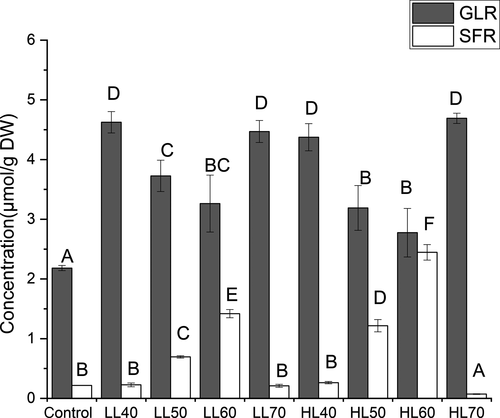This 2020 study provided details about healthy sinapic acid broccoli sprout compounds:
“Anti-inflammatory effects of broccoli sprouts have been demonstrated in vivo, but the connection with composition is not yet fully explained. The aim of the present study was:
- Provide a complex qualitative / quantitative insight into variability of SADs [sinapic acid derivatives] during germination of broccoli sprouts; and
- Investigate their antioxidant and anti-inflammatory properties that might result from the presence of phenolics.
Sprouting in darkness results in overall decrease in total content of SADs with growth time, but promotes replacement of relatively low active constituents, such as sinapine, by stronger antioxidants. These structural changes are beneficial for total antioxidant capacity of broccoli sprouts, and are correlated with their increasing ability to scavenge free radicals, reduce transition metal ions, and inhibit lipid peroxidation.”

The graphic’s dotted line is sinapine.
“Anti-TNF-α activity of broccoli sprout extract and sinapic acid was less relevant than that of an anti-inflammatory drug DEX [dexamethasone]. However, contrary to DEX, they significantly stimulated release of IL-10, which is an anti-inflammatory and immunosuppressive factor. By downregulating secretion of pro-inflammatory cytokines, IL-10 may impede immunopathology by inhibiting activity of macrophages, natural killer cells and lymphocytes.
Most of the previous studies ascribed anti-inflammatory effects of broccoli sprouts to their sulfur compounds only. Research data from in vivo models confirmed that glucosinolates may stimulate IL-10 release while isothiocyanates do not influence significantly or even decrease its production.
The present study indicates that phenolic constituents may also be responsible for anti-inflammatory effects of broccoli sprouts, and stimulation of IL-10 might be most relevant in this context.”
https://pubs.rsc.org/en/content/articlelanding/2020/FO/D0FO01387K “Variability of sinapic acid derivatives during germination and their contribution to antioxidant and anti-inflammatory effects of broccoli sprouts on human plasma and human peripheral blood mononuclear cells” (not freely available)
Some aspects of this study:
1. Seed-2-4-6 day measurements complemented seed-3-5-7 day measurements of the superb 3-day-old broccoli sprouts have the optimal yields. Both studies used standard methodologies, provided convertible dry weight and fresh weight measurements in mg / g, and grew their sprouts in darkness, with the current study watering every 12 hours.
The current study measured composition changes of 31 compounds (18 sinapic acid derivatives, 8 glucosinolates, and 5 flavonoids). It was too complicated for me to sum up and convert these granular dry weight measurements to make them directly comparable with 3-day study total phenolics (TP below, and TF is total flavonoids). They decreased similarly to TP mg / g fresh weight measurements.
The 3-day study also compared each cultivated variety’s germination stage weights and measurements with its origin using a milligram-per-gram-of-seeds scale:
“To be comparable, the content of these bioactive compounds from 100 fresh sprouts was divided by the weight (g) of 100 seeds, and then this value was compared with their content from one gram seeds.
The seed weight of XM was nearly twice that of other varieties and its sprouts weight also had the highest increasing rate. LWW and LY had the lowest weight of seeds as well as sprouts.”

Different lowercase letters meant significant differences in the same cultivar among sampling days, and uppercase in the same sampling day among cultivars.
A. That study’s mg / g fresh weight trend favored broccoli seeds, a subject explored in Microwave broccoli seeds to create sulforaphane. Seeds of all six cultivars were significantly higher than their sprouts in TP, TF, and sulforaphane in this paradigm.
B. The mg / g seed trend favored 3-day-old broccoli sprouts for TP (five of six cultivars), TF (all), but not sulforaphane (two of six). Both trends were scientifically informed.
Which paradigm suits you?
2. A 2005 study was cited for:
“Total glucosinolate content in fresh broccoli sprouts were reported to reach 4.02 μmol/g fw, which corresponds to 0.71 mg/g fw of active isothiocyanates. In our study, total content of SADs in 6-day-sprouts was 4.85 mg/g dw. Recalculating to fresh weight gives 0.37 mg/g fw, which suggests that SADs might well influence biological effects of glucosinolates.”
The current study measured eight glucosinolates but no isothiocyanates. Don’t think this 2005 study provided bases for close comparisons, since it had unknown broccoli cultivar, unknown sprout age, and unanalyzed isothiocyanates.
Comparisons to a two-decimal-point precision should use the same cultivar and contexts, to include growing conditions. For example:
- The 3-day study showed wide variation in sulforaphane weights among six broccoli cultivars’ seeds, from 2.43 mg to 12.07 mg per gram of seeds. And:
“Knowledge concerning the bioavailability of plant ITCs is essential to predict the potential level of exposure as GL determination alone may not accurately reflect how much of the final active ITC can be formed from sprouts.”
- The three cultivars studied in Lab analyses of broccoli sprout compounds had broccoli sprout sulforaphane amounts vary from 0.3 to 1.2 μmol / g fw in one growing season, then from 0.2 to 0.6 μmol / g fw the next year.
But these researchers knew that:
“In a study, diminishing amounts of total phenolic acids in sprouts of three broccoli cultivars was observed only between 3rd and 7th day of germination under photoperiod conditions and only when expressed on fresh weight basis. After recalculating results to dry weight, amounts were increasing during the whole 14-day observation period.
Trends cannot be treated as universal, but are dependent on growth conditions and variety of the plant.”
“0.37 mg/g fw” of Day 6 sinapic acid derivatives would be lower than Day 7 of four 3-day study cultivars’ total phenolics, and between Days 5 and 7 of the other two. I’d guess that the current study’s cultivar, Cezar, would be neither the lowest nor the highest cultivar if comparably measured for total phenolics.
3. These researchers compared other studies to an extent that isn’t usually seen. The result was good information such as:
“The most significant difference is sinapine that was not detected in either of the two above mentioned works, but is a major component of extracts investigated in the present work.
In one study, 7-day-sprouts were germinated under photoperiod conditions and without monitoring the phenolic profile in preceding growing days. Dominating constituents identified were trisinapoyl-gentiobiose, that was also present in relevant quantities in 6-day-sprouts, and sinapoyl-malate, that was not detected in our study.
Taking into account the significant role of these compounds (especially sinapoyl-malate) in UV-protection, light availability might have caused much quicker sinapine degradation and synthesis of SADs more suitable for those conditions. The same study also demonstrated that additional UVA and UVB irradiation before harvest further induced production of some of the constituents.“
4. Flavonoids and hydroxycinnamic acids are subgroups of phenolic compounds. Sinapic acid derivatives are a category of hydroxycinnamic acids.
Would microwaving sinapic acid derivatives have similar effects to what was described in Microwave broccoli to increase flavonoid levels? That’s the subject of Microwaving broccoli sprouts may not affect phenolic levels.























 Landing eagle
Landing eagle
 Young dolphins eating breakfast
Young dolphins eating breakfast







